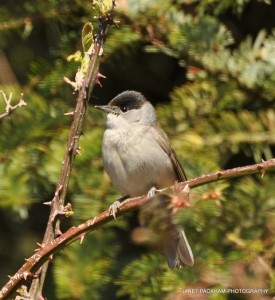Reserve Sightings
Over the last few days we have been lucky enough to count a male Blackcap as one of our regular visitors, seen regularly feeding on the apples that we have placed around the centre. Male Blackcaps are easily identified, as the name suggests, by the striking black cap that sits atop its otherwise grey body. Female Blackcaps differ from the males in having a brown cap instead of black. Traditionally a summer visitor to Britain, the Blackcap has changed its habits and can now be found on our shores all year round. Although the majority of our breeding birds still fly south in autumn, they are now replaced by birds that move west from central Europe to spend the winter here. Blackcaps feed mainly on insects during the breeding season before changing their diet to predominantly fruit over the winter. Birds that have started over wintering in the UK rely heavily on food that they find in our gardens, with bread and sources of fat particularly important to them, along with berries from cotoneasters, ivy and honeysuckle. Due to the importance of garden feeding stations to their survival over the winter, Blackcaps are fiercely territorial and will often repel competitors as large as Starling and Blackbirds. Interestingly, Blackcap nests are often targeted by Cuckoos, a well known parasitic species that lays its eggs in the nests of other species, who are often tricked into raising them as their own offspring. Blackcaps are however, good at tackling this problem, with each egg in their clutch being very similar in appearance, making it easy to spot any Cuckoo’s egg that may be laid with their own. Cuckoo’s are able to mimic the eggs of the host species, however, this is also made difficult as Blackcaps have great egg variation between their clutches.

Other sightings around the reserve in the past week have included 110 Pintails seen on the 20th, a Great Crested Grebe seen on the same day, good numbers of Scaup seen throughout the week, and a year to date high count of 33 Whooper Swans counted on the 19th. Sightings around the local area have included a Pomarine Skua at Lunan Bay on the 20th and 17 Waxwings on the 17th in Dundee. Kinnordy Loch near Kirriemuir has continued to throw up some interesting sightings, with a drake Snew being seen throughout the week along with further sightings of the Green-Winged Teal and a Bittern seen on the 17th.
The visitor centre will be open normal winter hours (Fri-Sun 10.30-4pm) over the festive period. The staff here in the Visitor Centre and on the reserve wish you a merry Christmas and a happy new year and we hope see you at some point over the holidays!
Craig Shepherd,
Visitor Centre Assistant Manager.
Help protect Scotland’s wildlife
Our work to save Scotland’s wildlife is made possible thanks to the generosity of our members and supporters.
Join today from just £3 a month to help protect the species you love.
Preface
Over the last few days we have been lucky enough to count a male Blackcap as one of our regular visitors, seen regularly feeding on the apples that we have …
